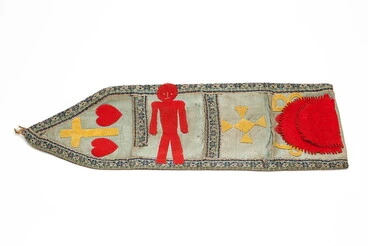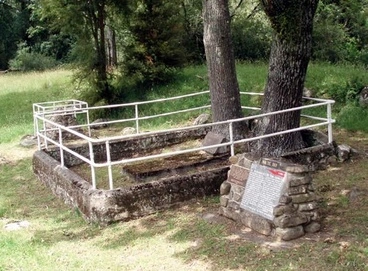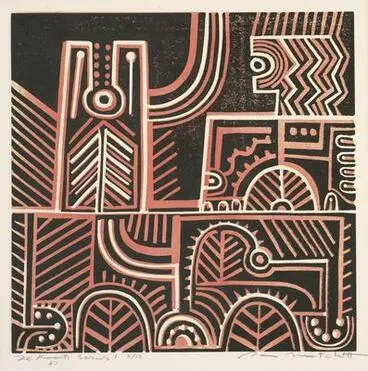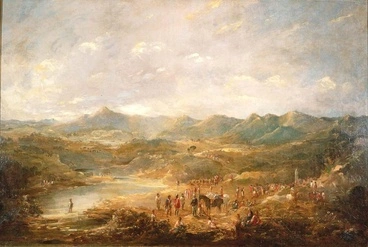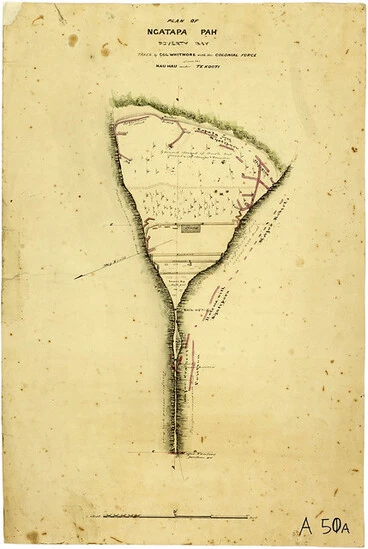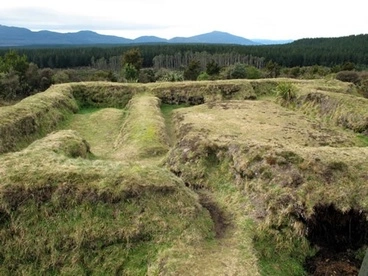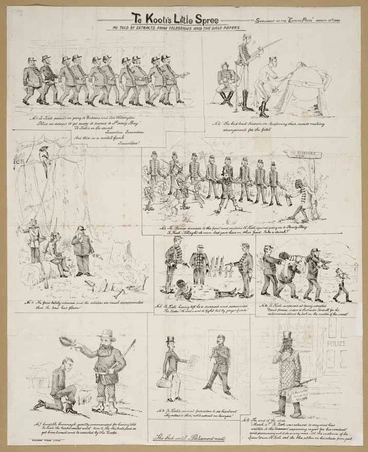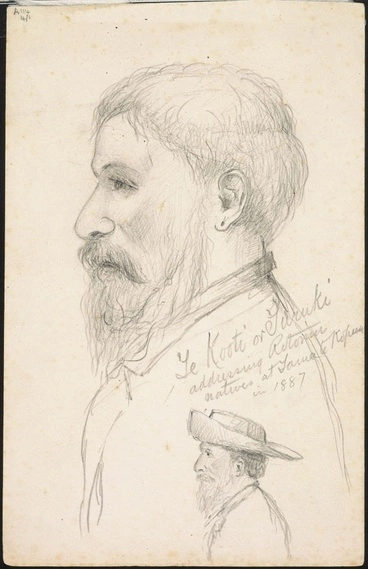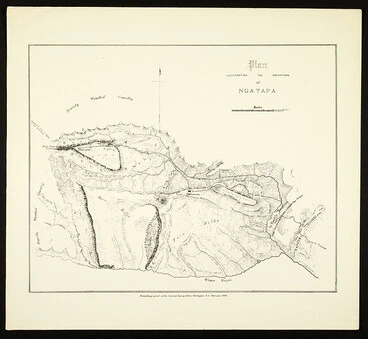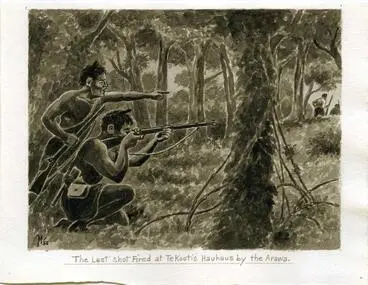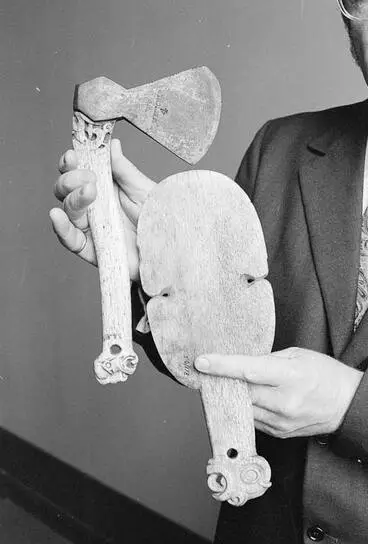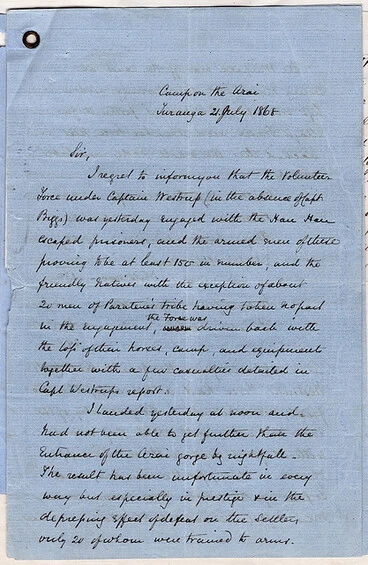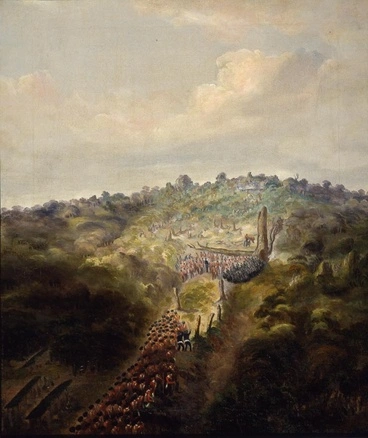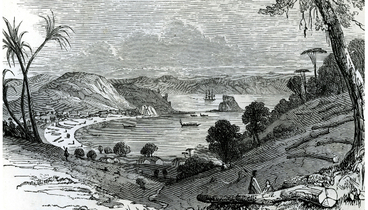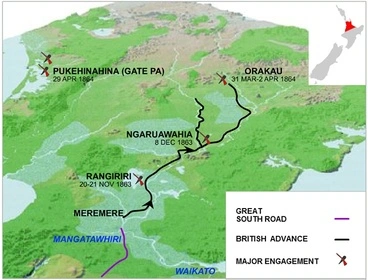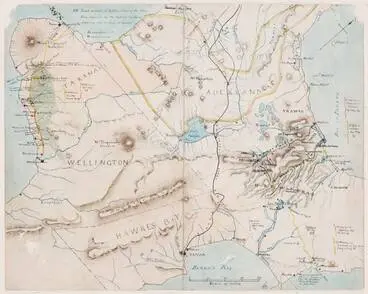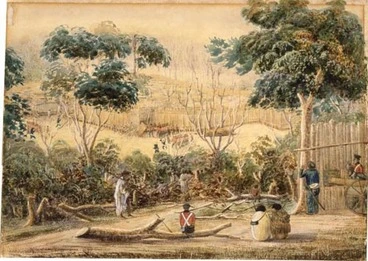The story of Te Kooti 1868-73
A DigitalNZ Story by National Library of New Zealand Topics
Te Kooti was a Māori leader and founder of the Ringatū religious movement. He was exiled to the Chatham Islands in 1866, but escaped two years later and successfully evaded government authorities in the central North Island and East Coast regions. SCIS no. 1966150
social_sciences, arts, english, history, health, Māori, technology
Banner possibly used by Te Kooti
Archives New Zealand Te Rua Mahara o te Kāwanatanga
Prisoners exiled to the Chatham Islands
Manatū Taonga, the Ministry for Culture and Heritage
Waitangi, Chatham Islands
This photo taken by Alfred Martin of the Chatham Islands shows Te Kooti’s jail behind the courthouse with a flag in front of it. Te Kooti was arrested in 1866 for warning local Pai Mārire of action to be taken against them. He, along with a boatload of Pai Mārire followers, were exiled to Chatham Island (Wharekauri). Te Kooti spent 2 years on the islands. It was here when he lay ill with a fever that he described being spoken to by God to teach and lead his people. On 4 July 1868, Te Kooti and around 300 prisoners overpowered a visiting ship (the Rifleman) and forced the crew to sail them back to the East Coast of New Zealand.
Alexander Turnbull Library
The Te Kooti trail, 1927
Manatū Taonga, the Ministry for Culture and Heritage
Te Kooti's war - Te Kooti's war
Manatū Taonga, the Ministry for Culture and Heritage
TE KOOTI IN THE KING COUNTRY - (Te Ao Hou - No. 26 March 1959)
Alexander Turnbull Library
Te Kooti Chair, Urewera
Auckland War Memorial Museum Tāmaki Paenga Hira
Ruakituri NZ Wars memorial
Manatū Taonga, the Ministry for Culture and Heritage
Grants of land to Rewi and Te Kooti
Museum of New Zealand Te Papa Tongarewa
Te Kooti’s whip
Manatū Taonga, the Ministry for Culture and Heritage
Te Kooti goes to Te Kūiti - Te Kooti's war
Manatū Taonga, the Ministry for Culture and Heritage
Wife of Te Kooti
Alexander Turnbull Library
TE KOOTI PARDONED. (Clutha Leader, 16 February 1883)
National Library of New Zealand
WHY TE KOOTI WAS PARDONED. (Grey River Argus, 27 April 1883)
National Library of New Zealand
How Te Kooti Gained a Pardon - Historic Poverty Bay and the East Coast, N.I., N.Z.
Victoria University of Wellington
THE UREWERA DESERT TE KOOTI. (Daily Southern Cross, 02 August 1869)
National Library of New Zealand
Sketch of Te Kooti made at Te Teko
Alexander Turnbull Library
Te Kooti
Auckland Art Gallery Toi o Tāmaki
The meeting of Josiah Firth with Te Kooti
Manatū Taonga, the Ministry for Culture and Heritage
Plan of Ngatapa Pā, 1868-69
Archives New Zealand Te Rua Mahara o te Kāwanatanga
Redoubt at Onepoto
Alexander Turnbull Library
PAPERS RELATIVE TO SURRENDER OF REBEL NATIVES AND EXPEDITIONS IN SEARCH OF TE KOOTI.
National Library of New Zealand
TE KOOTI. (Marlborough Express, 21 February 1883)
National Library of New Zealand
Te Pōrere redoubt
Manatū Taonga, the Ministry for Culture and Heritage
The upraised hand or the spiritual significance of the Ringatū faith
Services to Schools
Te Kooti's Little Spree
Manatū Taonga, the Ministry for Culture and Heritage
Boy Scouts on the trail of Te Kooti
Services to Schools
Rongowhakaata remember ancestors killed at Ōweta
Services to Schools
This bone club (kotiate) was carried by Te Kooti and the tomahawk (pātītī) was carried by Peka Makarini – one of Te Kooti’s trusted lieutenants. These weapons were designed for close combat. European trade had a significant impact on Māori weapon technology. Many warriors carried an adapted pātītī in their belts as a back-up weapon to firearms. Te Kooti was known to have carried his whalebone kotiate with him throughout his campaigns.
Weapons carried by Te Kooti and Peka Makarini
Alexander Turnbull Library
Wai 894: Te Urewera Pre-publication Part I
Services to Schools
Native affairs - Tūhoe and Te Kooti's history reclaimed
Services to Schools
Redemption Songs: A Life of Te Kooti Arikirangi Te Turuki
Services to Schools
The arrest and last days of Te Kooti
In this article Colonel Porter writes about his pursuit of Te Kooti in Opotiki, then his face-to-face meeting with him to persuade him to give himself up peacefully and to give up his plans to travel to the Waikato. When the request was denied Porter was forced to arrest Te Kooti. After his trial in Auckland, Te Kooti was then confined to a plot of land given by the Government. It was here that Te Kooti spent the rest of his life till his death in 1893.
National Library of New Zealand
Te Kooti’s body
Te Kooti died on 17 April 1893 at Te Karaka. He was first buried in Maromahue in Waiotake. Later on, his grave was opened and his coffin taken away. Māori at that time believed that he had risen from the dead like Jesus Christ. One story is that his body was spirited away to Gisborne in the dead of night, but the final destination remains undisclosed. This was done in keeping with custom, for fear that relatives of Te Kooti’s enemies may desecrate his grave.
National Library of New Zealand
Ko Whakaari Eripi
Ko Whakaari Eripi at Te Whaiti was opened by Te Kooti in 1884. It was supposed to be Te Kooti’s most sacred whare in Te Urewera country. Matches, pipes and tobacco were prohibited inside this house. This watercolour by Thomas Ryan in 1891 shows an elaborately carved whare with Te Kooti’s predictive words for the house ‘Ko Whakaari Eripi on the sloping maihi (barge board). Unfortunately, the whare was abandoned because of an ill omen in the carving on the central pole (poumua) - a lizard (ngarara) was depicted upside down.
Alexander Turnbull Library
Te Kooti's flag, Te Wepu
According to Judith Binney’s book “Redemption Songs,” this flag came into Te Kooti’s possession when he captured it in 1868. Te Kooti called it Te Wepu (the whip) because of the crackling noise it made when it flew. The flag measured around 16 meters in length and was made by nuns in Napier. It was decorated with a crescent moon, a cross, a six-pointed star and a bleeding heart. This was Te Kooti’s war flag. It was lucky that Gilbert Mair from the Waikato Militia made an ink drawing of the flag when he captured it in 1870 – because its current status is a mystery. Was the flag cut up by a museum and used as dusters, was it shortened, was it stolen, or is in the possession of the Ringatū chu
Alexander Turnbull Library
Mohaka April 1869
On 10 April, on his way to Te Huki pā in Mohaka, Te Kooti attacked settlements in the surrounding area. He did this to stock up on food supplies and ammunition, and for revenge against tribes that opposed him. He left many Māori dead – men, women and children. Also killed were the Lavin family and an elderly farmhand (seven people in all). This was done because John Lavin had been part of the militia during the war in the upper Wairoa.
Alexander Turnbull Library
The prison on Chatham Islands
Services to Schools
The New Zealand Wars: Ngā Pakanga o Aotearoa
Services to Schools
Te Kooti jailed on trumped-up charges
Services to Schools
View of Harema Pah by Thomas Ryan
Services to Schools
The arrest of Te Kooti
Services to Schools
Te Kooti – voices from the Iwi
Services to Schools
Land ownership
Services to Schools
Te Kooti's manuscripts displayed for the first time
Services to Schools
Captain Thomas’ account of the career of Te Kooti
Services to Schools
Ark of salvation – Te Kooti lands a new religion
Services to Schools
The New Zealand Wars
Services to Schools
Archives New Zealand images
Services to Schools
Letter from Te Kooti Te Turuki to Karanama
Alexander Turnbull Library
Te Kooti in 1887
Manatū Taonga, the Ministry for Culture and Heritage
Photographer unknown :Portrait of wives of Te Kooti and Topia
Alexander Turnbull Library
Ryan, Thomas Aldworth, 1864-1927 :[Portrait of Te Kooti. 1889 or 1891?]
Alexander Turnbull Library
Plan illustrating the operations at Ngatapa Pā, 1884
Archives New Zealand Te Rua Mahara o te Kāwanatanga
Weapons carried by Te Kooti and Peka Makarini
Manatū Taonga, the Ministry for Culture and Heritage
Te Kooti defeats Captain Wistrup's Force, 1868
Archives New Zealand Te Rua Mahara o te Kāwanatanga
The pursuit of Te Kooti
Manatū Taonga, the Ministry for Culture and Heritage
Te Whai-a-te-Motu meeting house
Manatū Taonga, the Ministry for Culture and Heritage
Armed Constabulary posts: Ōpepe, 1870s
Manatū Taonga, the Ministry for Culture and Heritage
War in Tauranga 1864
DigitalNZ
The Story of Rua Kēnana, 1916
DigitalNZ
